What are Stomach Diseases? Symptoms and Treatment Methods
İçindekiler
- 1 What are Stomach Diseases? Symptoms and Treatment Methods
- 1.1 Stomach Diseases
- 1.2 Symptoms of Stomach Diseases
- 1.3 Stomach Cancer Surgery
- 1.4 Types of stomach cancer surgery and removal of lymph nodes
- 1.4.1 Stomach and lymph nodes
- 1.4.1.1 Esophageal gastric junction cancer
- 1.4.1.2 Upper stomach cancer
- 1.4.1.3 Middle stomach cancer
- 1.4.1.4 Lower stomach cancer
- 1.4.1.5 Surgery for esophageal gastric junction cancer
- 1.4.1.6 Surgery for upper stomach cancer
- 1.4.1.7 Surgery for middle stomach cancer
- 1.4.1.8 Surgery for lower stomach cancer
- 1.4.1.9 Surgery for early stomach cancer
- 1.4.1 Stomach and lymph nodes
- 1.5 Examples of laparoscopic - robotic stomach cancer surgery
- 1.6 Stomach Cancer and Surgery - Frequently Asked Questions
Stomach Diseases
Within the stomach, which has the task of storing, mixing, and breaking down food, there is stomach acid. The stomach acids that facilitate digestion can damage the stomach. This is why the stomach has a stomach lining. The stomach lining prevents stomach acids from attacking the stomach wall. Various stomach diseases can also occur when the sensitivity of the stomach lining is impaired. Conditions of daily life that cause irregular stomach movements can negatively affect a person’s life. Various forms of stomach diseases such as stomach cancer, digestive disorders, heartburn, stomach ulcers, and gastritis can cause bigger problems in the future if left untreated.
Located between the esophagus (esophagus) and duodenum (duodenum), the stomach is a special organ with surgically unique anatomy and vascular structure. The types of surgeries used in the treatment of stomach cancer have not changed much in the last 20 years. However, as a result of advances in medicine, the feasibility of gastric surgeries with minimally invasive methods has increased, and today both resections and functional surgeries can be performed by closed method with laparoscopic and robotic surgery.
What are Stomach Diseases?
The stomach lining, which completely covers the inside of the stomach, protects the stomach against gastric juices. Nevertheless, inflammation of the stomach lining can cover the entire stomach. This can lead to abdominal pain, heartburn, nausea, and belching. A stomach ulcer occurs when a certain area of the stomach lining is destroyed. When stomach acid comes into contact with this damaged area, it causes ulcers. Stomach ulcers can also be triggered by the use of spicy spices, excessive consumption of tea and coffee, restlessness, and stress. Food comes back from the stomach to the esophagus in ulcer disease, which is popularly called heartburn. This irritates the lining.
The Impact of Stomach Diseases on a Person
It is characterized by different factors such as pressure in the heart area, belching, nausea, and heartburn cause the person to feel uncomfortable. In addition to all these, digestive disorders are among the stomach diseases. Digestive disorders, which manifest themselves with many different symptoms such as bad breath, white tongue, stomach pain, heartburn, gas, and bloating, help protect your health with proper nutrition. One of the most important stomach diseases is stomach cancer. Stomach cancer, which manifests itself with different symptoms such as weight loss and loss of appetite, can occur due to various factors. Besides, remember that ulcers in the stomach have the risk of developing into cancer over time.
The Impact of Stomach Diseases on the Digestive System
The digestive system is one of the most important functions of life. Functioning to break down food into its building blocks, the digestive system ensures that the unused parts of food are converted into feces. Depending on the severity and type of the disease, digestive system diseases can cause serious problems that affect other organs of the body. Gastroenterology specializes in diseases of the digestive system, which can manifest themselves in many different factors such as vomiting, nausea, defecation problems, discomfort, and pain. Digestive system diseases may include gallbladder diseases, liver diseases, hemorrhoids, pancreatitis, constipation, indigestion, stomach ulcers, gastritis, and reflux disease.
Importance of Stomach Diseases
Reflux disease, which is usually unrecognized by patients, occurs with the escape of stomach contents into the esophagus. If stomach contents escape into the esophagus while sleeping or frequently during the day, it is a condition that needs to be taken seriously. As a consequence of esophageal damage such as erosion and ulcers, reflux disease can also cause problems such as difficulty swallowing and burning in the chest. The person needs to ensure proper weight control to control reflux, which causes problems such as acidic fluid in the mouth, difficulty swallowing, and burning in the chest. Left untreated, reflux disease can lead to stenosis in the lower end of the esophagus.
Other Stomach Diseases and Symptoms
Gastritis is another stomach disease. Gastritis is one of the most important factors that cause inflammation in the mucous lining of the stomach. Wounds can be healed by using medicines that help reduce stomach acids. In gastritis caused by bacteria, you can start antibiotic treatment with the doctor’s recommendation. One of the most common stomach diseases is stomach ulcers.
A stomach ulcer, which occurs when the stomach tissue is damaged, causes wounds to form in the damaged stomach tissue due to digestive secretions. The habits of coffee, smoking, and alcohol are among the triggering factors in the formation of stomach ulcers. If left untreated, this disease can lead to fluid accumulation in the abdominal cavity. Although stomach ulcers are treated with surgical interventions, medication, and diet, they can also be caused by different factors such as excessive consumption of acidic foods, stress, and genetic predisposition. Do not neglect stomach disorders and consult your doctor when these symptoms occur.
Symptoms of Stomach Diseases
Stomach ulcers, functional dyspepsia, gastritis, and other conditions can vary from person to person. All these problems, however, have common symptoms of discomfort. For example, in the case of gastritis, bad breath, belching, a constant feeling of fullness in the stomach, bloating, indigestion, burning in the stomach, and increasing pain may occur. To diagnose gastritis, the person’s metabolic diseases and stomach microbes are checked. If the patient is to be treated for a short period, endoscopic examinations are usually not used and the problem is solved with medication. Endoscopy may be planned if the patient has a family history of cancer.
According to the spread of stomach cancer, the treatment method can be determined. You should avoid harmful habits such as alcohol and smoking and consume healthy foods to prevent stomach cancer. You should be screened for stomach cancer at certain intervals if you have a family history of stomach cancer. This will enable you to diagnose the disease early and make the treatment process much more comfortable.
Stomach Diseases and Symptoms
On the other hand, functional dyspepsia is a disorder that does not occur with organic pathology tests. The psychologically painful functional dyspepsia manifests itself with problems such as indigestion, abdominal pain, and burning in the stomach. Having an ulcer-like character, functional dyspepsia is one of the most important indicators of the effect of psychological factors on the stomach. The problems that the person feels with this disorder should be supported by medication. Another stomach disease, ulcer, refers to the irritation of the tissue layer in the stomach and the disruption of tissue integrity. Symptoms of stomach ulcers include diarrhea, black stools, weight loss, vomiting, and nausea. Those with severe stomach ulcers may experience fever, chills, sweating, low blood pressure, and severe abdominal pain.
The Role of Cancer in Stomach Diseases
Stomach cancer is the 5th most common type of cancer in western countries and our country. In far eastern countries such as Japan, it is very common and is one of the leading causes of death. Unfortunately, in Turkey, the majority of stomach cancers are detected after they have passed the early stage and spread to neighboring lymph nodes. It can be removed endoscopically when stomach cancer is caught at a very early stage. However, in our country, these patients constitute only 5% of all stomach cancer patients. Otherwise, surgical removal of the stomach and adjacent lymph nodes is the only method that significantly increases the chance of survival if caught at the appropriate stage. It is even possible to completely get rid of the disease when the correct surgical technique is applied to stomach cancer detected at an early stage.
Only a small number of patients have stomach cancer involving surrounding organs; in these patients, the spleen and the tail of the pancreas are often removed along with the stomach. Rarely, resection of the liver and large intestine is also necessary. Chemotherapy and radiotherapy are required in addition to surgery in some patients with stomach cancer. In case the stomach cancer involves the entrance part of the stomach, the tumor shrinks first with chemotherapy (neoadjuvant treatment) before surgery, and then surgery is performed. Surgery for stomach cancer most commonly performed are total gastrectomy, in which the entire stomach is removed, distal subtotal gastrectomy, in which the middle and outlet parts of the stomach are removed, and proximal gastrectomy, in which the lower end of the esophagus and the entrance part of the stomach are removed. Each of these operations can be performed with laparoscopic and robotic surgical methods in selected cases.
Types of Stomach Cancer
Stomach cancer can generally be divided into four groups according to the area where it develops:
- Cancers extending into the esophagus at the entry site from the esophagus to the stomach
- Cancers developing in the upper region of the stomach
- Cancers developing in the middle region of the stomach
- Cancers developing in the stomach near the exit (lower) region
This categorization of stomach cancer by region also determines the type of surgery to be performed. Because according to the location of the tumor in the stomach, both the part and size of the stomach to be removed and the cleaning of the lymph nodes differ.
Both the upper part of the stomach and the lower part of the esophagus are removed in tumors extending from the stomach entrance to the esophagus, and complete cleansing is achieved with lymphatic dissection. With these tumors, the remaining part of the stomach can be directly connected to the esophagus. Removal of the entire stomach may be necessary for cancers of the upper and middle regions of the stomach to perform adequate lymph node cleansing and to avoid leaving cancerous tissue behind. Lower and middle parts of the stomach are removed and 30-40% of the stomach is left behind for cancers that have developed in the lower part of the stomach and near the exit.
In all suitable patients, we prefer to perform surgery to leave at least 25% stomach. This is what is scientifically recommended.
Stomach Cancer Surgery
Performed to improve the quality of life of the person and to treat cancer, stomach cancer surgery helps to treat digestive system disorders. In stomach cancer surgery is performed with different application methods such as partial gastrectomy or total gastrectomy, which means complete removal of the stomach, the cancerous stomach tissue as well as the lymph nodes around it are removed. Surgical treatment for stomach cancer can take between 2 hours to 5 hours, depending on the patient and the occurrence of cancer. Stomach cancer surgery is very important for the person to regain his/her health. The clinical condition of the patient, the stage at which the disease is diagnosed, and the type and method of treatment may vary from person to person. Although the earlier the cancer is diagnosed, the higher the success rate of the treatment.
The first requirement for laparoscopy in gastric cancer is good lymphatic tissue clearance, as in open surgery. This means that it is necessary to remove not only the stomach but also the surrounding lymph nodes that cancer may have reached.
We have significantly increased our laparoscopic and robotic surgery rate for stomach cancer in recent years. Distal subtotal gastrectomy, in which two-thirds of the stomach is removed, is performed laparoscopically in 80% of patients. The laparoscopic method is used in 50% of total gastrectomy surgeries in which the entire stomach is removed. The rate for proximal gastrectomy is similar.
In the case of a Gastrointestinal Stromal Tumor (GIST), a non-cancerous and generally more benign tumor of the stomach, it is sufficient to remove only the part of the stomach containing the tumor. This is called wedge resection or partial gastrectomy. In these cases, lymph node cleansing is usually not necessary. Laparoscopic surgery can almost always be performed today for tumors in the form of GISTs.
Esophageal cancer is a common type of cancer, especially in the eastern Anatolia region of Turkey. Depending on its location, esophageal cancer is treated in different ways. Cancers that occur in the pharyngeal and neck parts of the esophagus are usually not operated on but treated with radiotherapy. Esophageal tumors of the middle part of the esophagus usually require complete removal of the esophagus, the stomach is formed into a tube and connected to the lower end of the esophagus in the neck region. For tumors near the junction of the esophagus and stomach, three-quarters of the esophagus is removed and the stomach is connected to the esophagus in the chest cavity. Patients with intermediate to advanced stages of the esophagus are given preoperative chemotherapy and radiation therapy to shrink the tumor first and then surgery is performed.
In recent years, esophageal cancer is increasingly being operated on with a closed method called laparoscopic – the thoracoscopic method, in which several holes are made in both the abdominal and chest cavity. More than half of the esophageal cancer surgeries we have performed in recent years are performed with the closed method (laparoscopic – thoracoscopic). Recovery after surgery in these patients is faster, the pain is less, and the return to normal life is shorter.
Stomach Cancer Surgery Alternatives
Stomach cancer surgery is actually surgery of the lymph nodes and tissues around the stomach. Why? This is because it is not very difficult to simply remove the stomach as an organ it is a procedure that is not very difficult in General Surgery applications. The most challenging part, which not all surgeons can perform with the same quality, is the removal of the lymphatic tissue around the stomach, where cancer cells may have spread, together with the lymph nodes. This is called lymphatic dissection. Lymph nodes are clustered around important vessels and it is necessary to perform lymphatic cleansing without damaging the vessels. High-quality dissection without leaving surrounding lymphatic tissue is the goal while preserving the vessels with care. In case of sloppy over-dissection, liver, and spleen feeding vessels may be damaged, while inadequate dissection may preserve vessels but leave cancerous lymphatic tissues around.
Although standards for lymphatic cleansing and dissection in gastric cancer have been largely established worldwide, when it comes to practical application, lymph node dissection may differ for each surgeon.
Scientific studies have shown that specialized surgeons and centers that do not perform all kinds of surgeries and work only in specific areas have better dissection quality, which reduces the development of postoperative complications and contributes to long-term survival.
You should definitely follow your doctor’s recommendations to get the best result in the treatment of stomach cancer, where methods such as immunotherapy, targeted therapy, radiotherapy, chemotherapy, and surgery are applied. Chemotherapy, one of the treatment methods used in gastric cancer, provides oral or intravenous administration of drugs developed for cancer treatment. These drugs also affect the tissues where cancer cells have spread. In some cases, radiotherapy can be given together with chemotherapy, and chemotherapy can also be given before gastric cancer surgery. Chemotherapy to shrink cancer cells and make them fit for surgery is called neo-adjuvant if it is administered before cancer surgery. Postoperative chemotherapy can also be given to prevent cancer recurrence and completely eliminate stomach cancer. Chemotherapy given after surgery is called an adjuvant.
After Stomach Cancer Surgery
The combination of radiotherapy and chemotherapy after surgery is called chemoradiotherapy. Highly effective in cases where the cancerous tissue cannot be completely removed by surgery, chemoradiotherapy increases the comfort and life expectancy of patients. Stomach cancer may have some risks and complications during the surgery process, as with other types of cancer. Lung and heart disorders may change depending on anesthesia in stomach cancer surgery, which can develop fatal side effects. After stomach cancer surgery, which is an extremely delicate surgery, the person should pay attention to his/her eating habits and avoid acidic drinks.
Stomach Cancer, Esophageal Cancer, and Surgery
Located between the esophagus (esophagus) and duodenum (duodenum), the stomach is a special organ with surgically unique anatomy and vascular structure. The types of surgeries used in the treatment of stomach cancer have not changed much in the last 20 years. However, as a result of advances in medicine, the feasibility of gastric surgeries with minimally invasive methods has increased, and today both resections and functional surgeries can be performed by closed method with laparoscopic and robotic surgery.
Stomach cancer is the 5th most common type of cancer in western countries and our country. In far eastern countries such as Japan, it is very common and is one of the leading causes of death. Unfortunately, in Turkey, the majority of stomach cancers are detected after they have passed the early stage and spread to neighboring lymph nodes. It can be removed endoscopically when stomach cancer is caught at a very early stage. However, in our country, these patients constitute only 5% of all stomach cancer patients. Otherwise, surgical removal of the stomach and adjacent lymph nodes is the only method that significantly increases the chance of survival if caught at the appropriate stage. It is even possible to completely get rid of the disease when the correct surgical technique is applied to stomach cancer detected at an early stage. Only a small number of patients have stomach cancer involving surrounding organs; in these patients, the spleen and the tail of the pancreas are often removed along with the stomach. Rarely, resection of the liver and large intestine is also necessary. Chemotherapy and radiotherapy are required in addition to surgery in some patients with stomach cancer. In case the stomach cancer involves the entrance part of the stomach, the tumor shrinks first with chemotherapy (neoadjuvant treatment) before surgery, and then surgery is performed. Surgery for stomach cancer most commonly performed are total gastrectomy, in which the entire stomach is removed, distal subtotal gastrectomy, in which the middle and outlet parts of the stomach are removed, and proximal gastrectomy, in which the lower end of the esophagus and the entrance part of the stomach are removed. Each of these operations can be performed with laparoscopic and robotic surgical methods in selected cases.
The first requirement for laparoscopy in gastric cancer is good lymphatic tissue clearance, as in open surgery. This means that it is necessary to remove not only the stomach but also the surrounding lymph nodes that cancer may have reached.
We have significantly increased our laparoscopic and robotic surgery rate for stomach cancer in recent years. Distal subtotal gastrectomy, in which two-thirds of the stomach is removed, is performed laparoscopically in 80% of patients. The laparoscopic method is used in 50% of total gastrectomy surgeries in which the entire stomach is removed. The rate for proximal gastrectomy is similar.
In the case of a Gastrointestinal Stromal Tumor (GIST), a non-cancerous and generally more benign tumor of the stomach, it is sufficient to remove only the part of the stomach containing the tumor. This is called wedge resection or partial gastrectomy. In these cases, lymph node cleansing is usually not necessary. Laparoscopic surgery can almost always be performed today for tumors in the form of GISTs.
Esophageal cancer is a common type of cancer, especially in the eastern Anatolia region of Turkey. Depending on its location, esophageal cancer is treated in different ways. Cancers that occur in the pharyngeal and neck parts of the esophagus are usually not operated on but treated with radiotherapy. Esophageal tumors of the middle part of the esophagus usually require complete removal of the esophagus, the stomach is formed into a tube and connected to the lower end of the esophagus in the neck region. For tumors near the junction of the esophagus and stomach, three-quarters of the esophagus is removed and the stomach is connected to the esophagus in the chest cavity. Patients with intermediate to advanced stages of the esophagus are given preoperative chemotherapy and radiation therapy to shrink the tumor first and then surgery is performed.
In recent years, esophageal cancer is increasingly being operated on with a closed method called laparoscopic – the thoracoscopic method, in which several holes are made in both the abdominal and chest cavity. More than half of the esophageal cancer surgeries we have performed in recent years are performed with the closed method (laparoscopic – thoracoscopic). Recovery after surgery in these patients is faster, the pain is less, and the return to normal life is shorter.
Types of stomach cancer surgery and removal of lymph nodes
The following pictures show the stomach and the lymph nodes and ducts clustered around it, where cancer cells can spread.
Stomach cancer can generally be divided into four groups according to the area where it develops:
- Cancers extending into the esophagus at the entry site from the esophagus to the stomach
- Cancers developing in the upper region of the stomach
- Cancers developing in the middle region of the stomach
- Cancers developing in the stomach near the exit (lower) region
Stomach and lymph nodes
Esophageal gastric junction cancer
Upper stomach cancer
Middle stomach cancer
Lower stomach cancer
This categorization of stomach cancer by region also determines the type of surgery to be performed. Because according to the location of the tumor in the stomach, both the part and size of the stomach to be removed and the cleaning of the lymph nodes differ.
As seen in the pictures below in the form of blue painted areas, both the upper part of the stomach and the lower part of the esophagus is removed in tumors extending from the stomach entrance to the esophagus, and complete cleansing is achieved with lymphatic dissection. With these tumors, the remaining part of the stomach can be directly connected to the esophagus. Removal of the entire stomach may be necessary for cancers of the upper and middle regions of the stomach to perform adequate lymph node cleansing and to avoid leaving cancerous tissue behind. Lower and middle parts of the stomach are removed and 30-40% of the stomach is left behind for cancers that have developed in the lower part of the stomach and near the exit.
In all suitable patients, we prefer to perform surgery to leave at least 25% stomach. This is what is scientifically recommended.
Stomach and lymph nodes
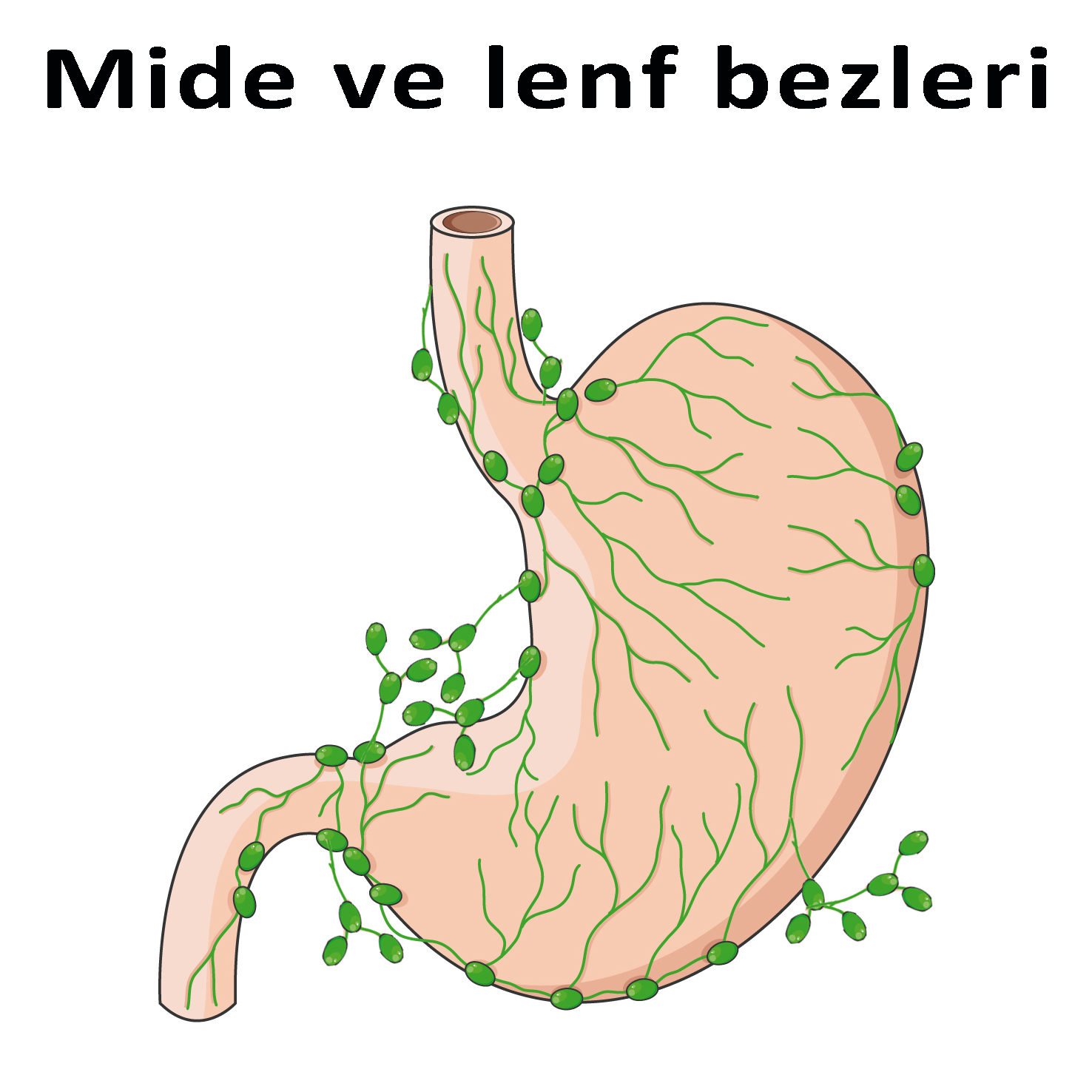
Esophageal gastric junction cancer
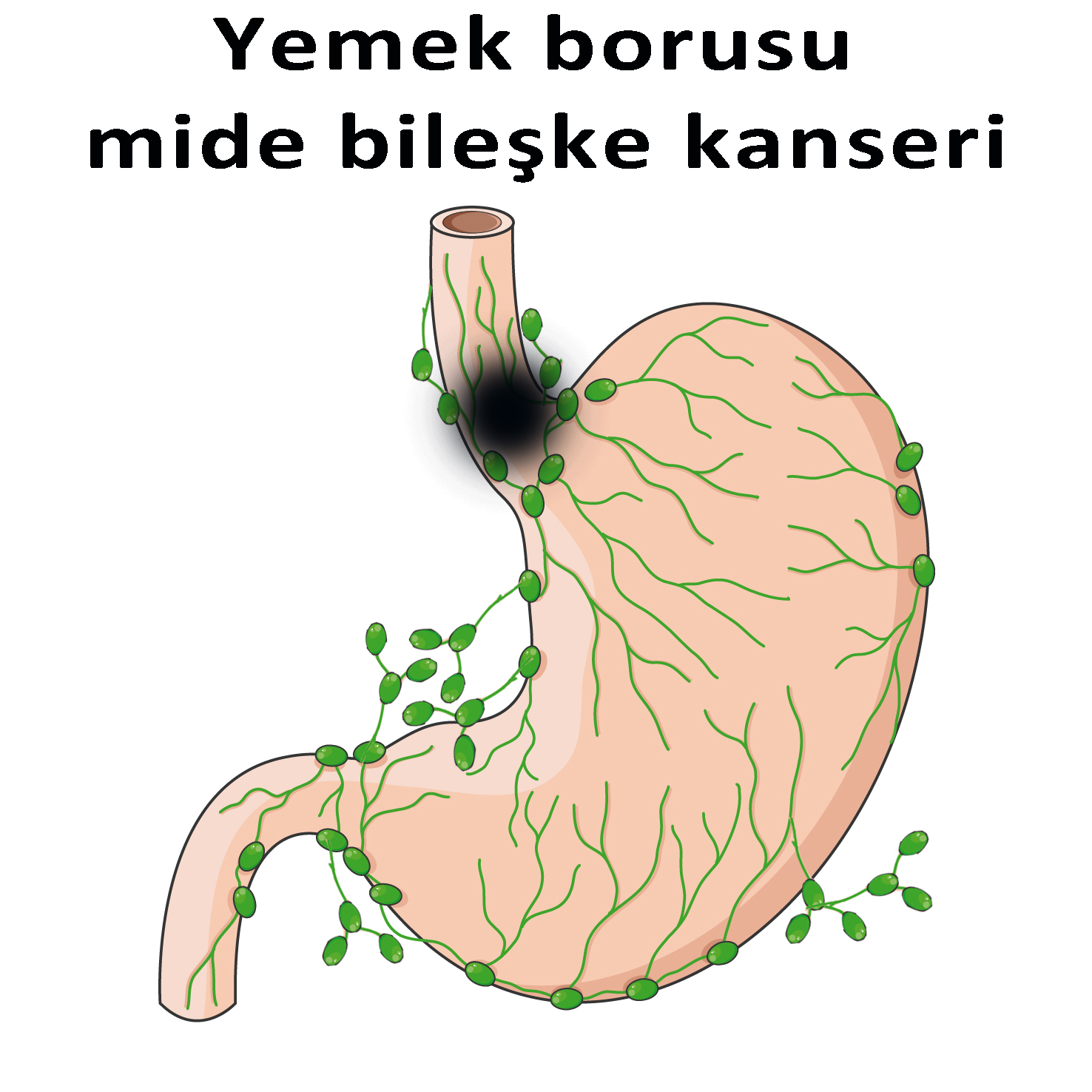
Upper stomach cancer
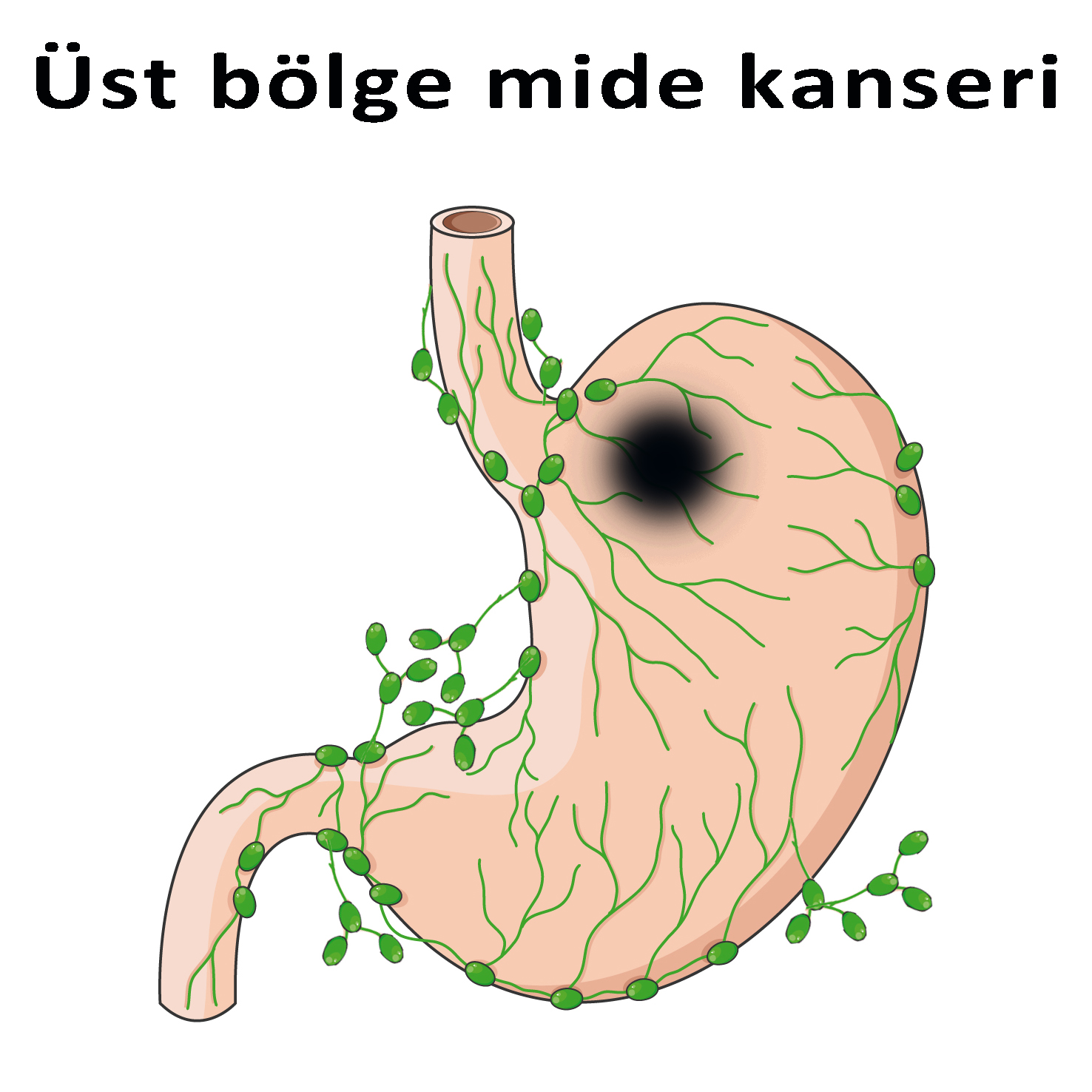
Middle stomach cancer
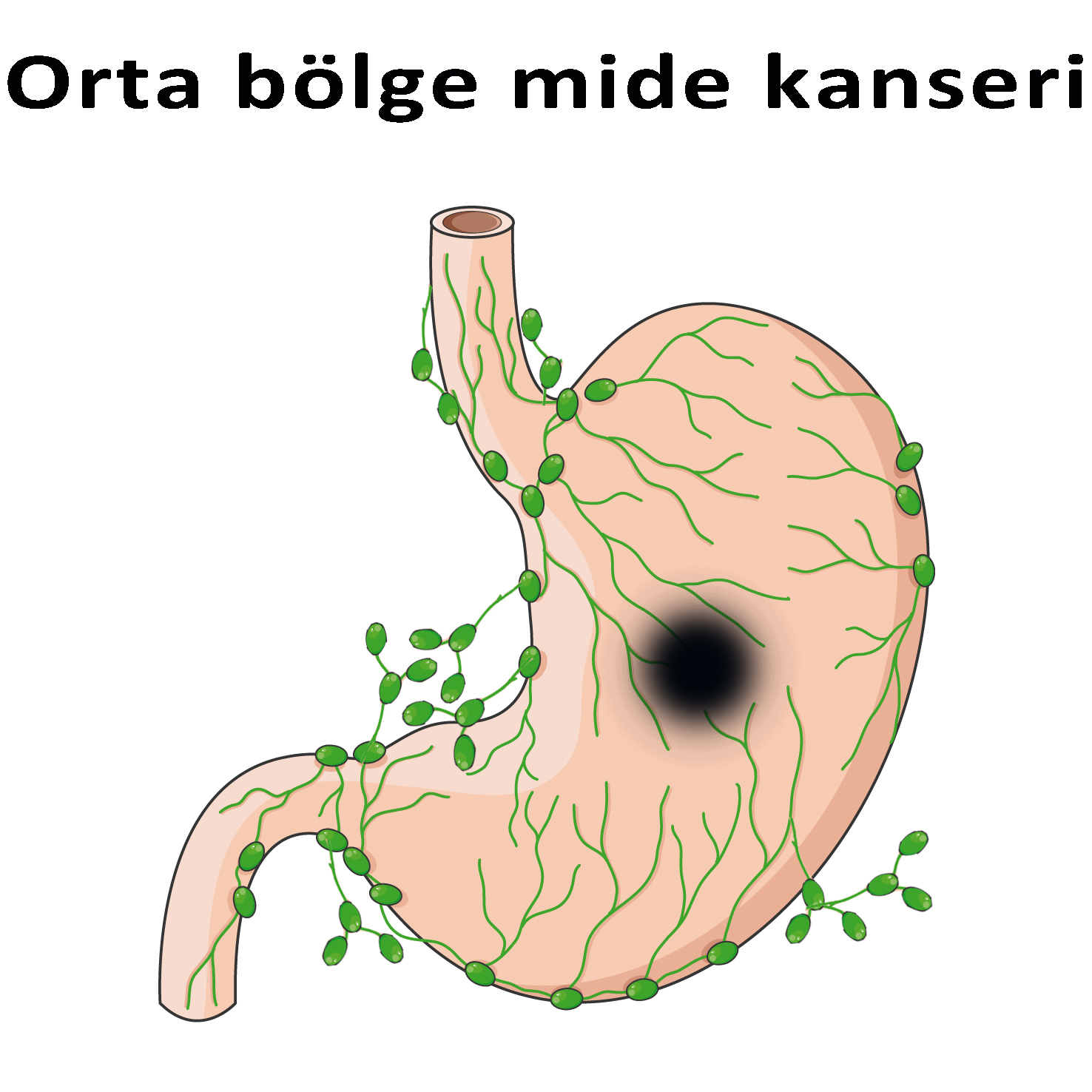
Lower stomach cancer
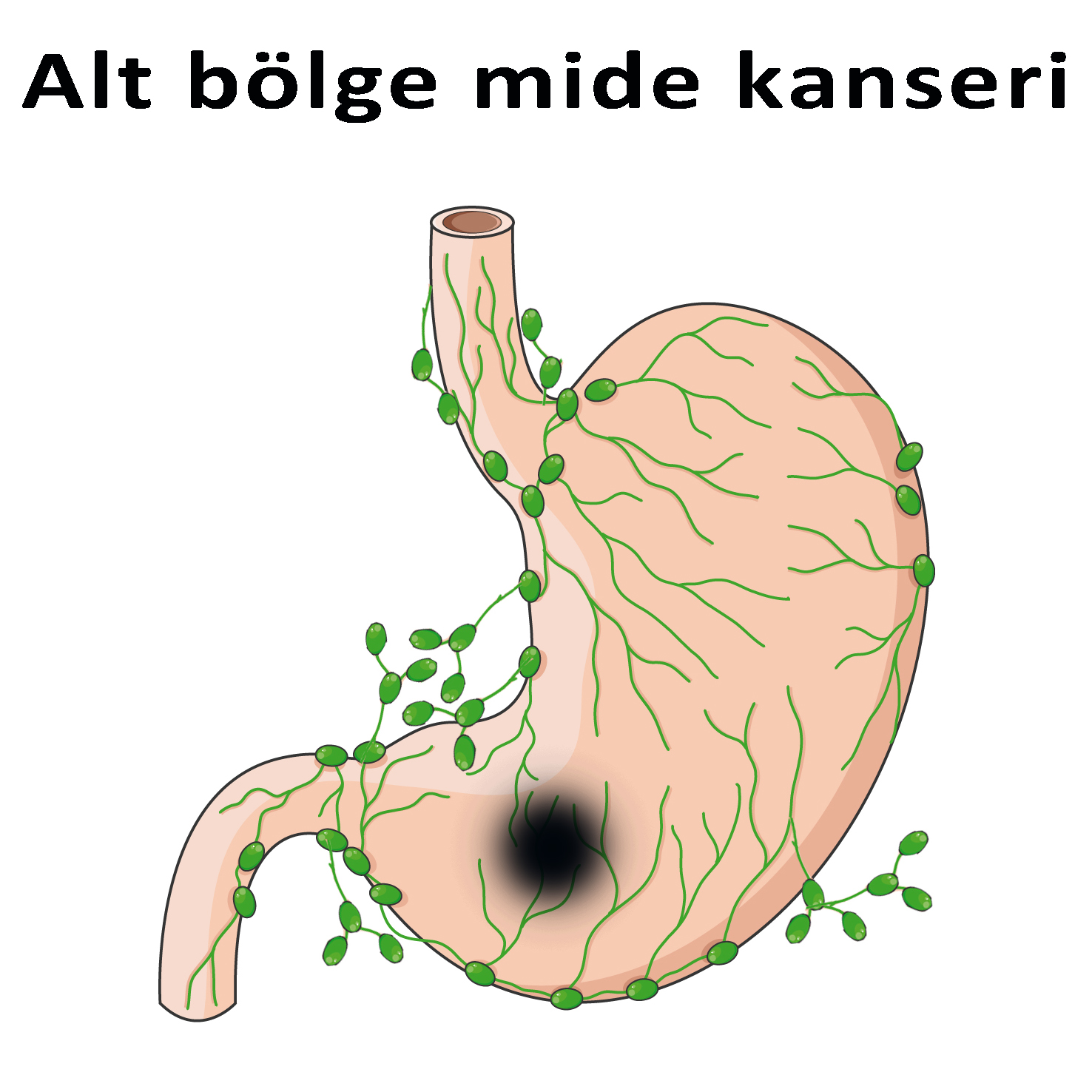
This categorization of stomach cancer by region also determines the type of surgery to be performed. Because according to the location of the tumor in the stomach, both the part and size of the stomach to be removed and the cleaning of the lymph nodes differ.
As seen in the pictures below in the form of blue painted areas, both the upper part of the stomach and the lower part of the esophagus is removed in tumors extending from the stomach entrance to the esophagus, and complete cleansing is achieved with lymphatic dissection. With these tumors, the remaining part of the stomach can be directly connected to the esophagus. Removal of the entire stomach may be necessary for cancers of the upper and middle regions of the stomach to perform adequate lymph node cleansing and to avoid leaving cancerous tissue behind. Lower and middle parts of the stomach are removed and 30-40% of the stomach is left behind for cancers that have developed in the lower part of the stomach and near the exit.
In all suitable patients, we prefer to perform surgery to leave at least 25% stomach. This is what is scientifically recommended.
Surgery for esophageal gastric junction cancer
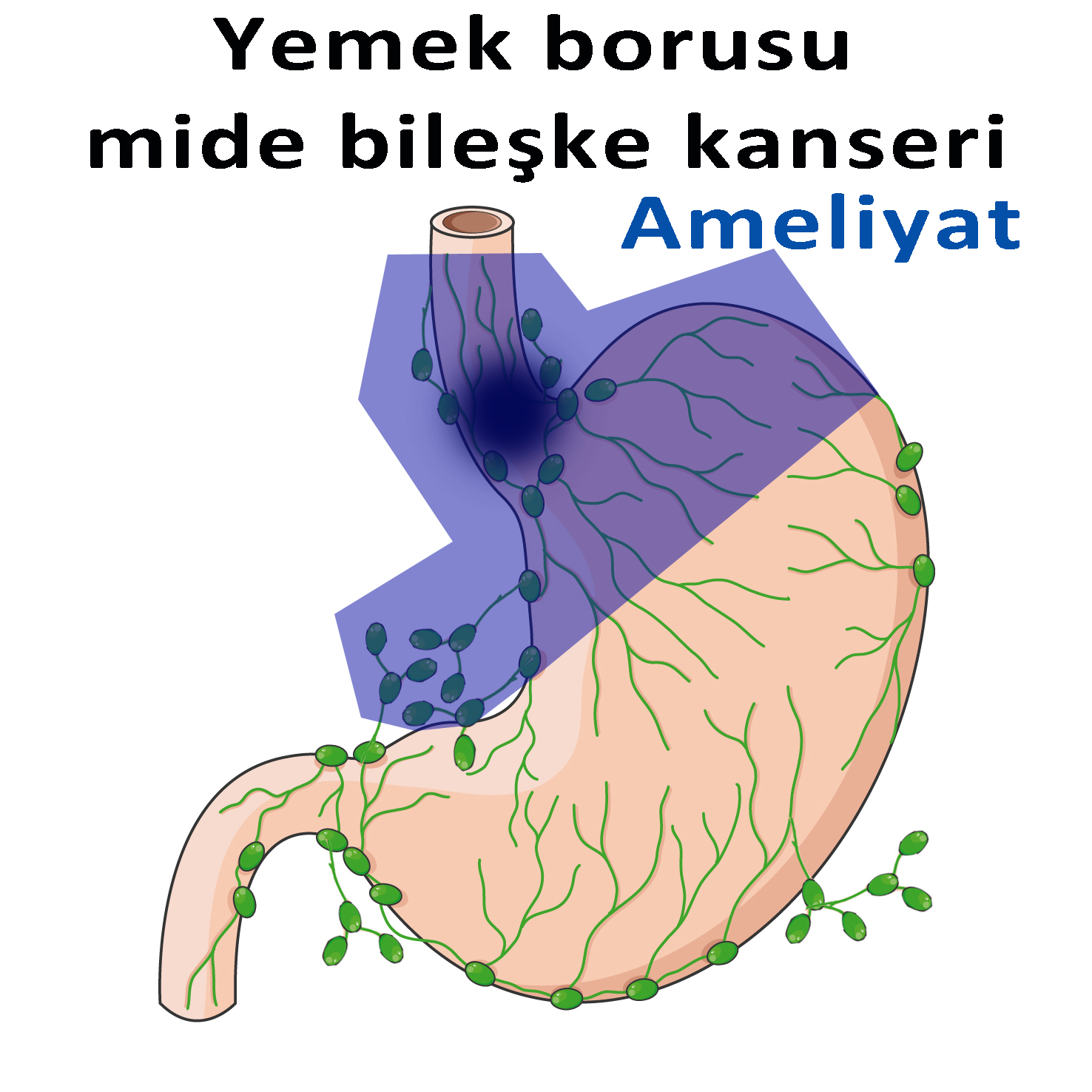
Surgery for upper stomach cancer
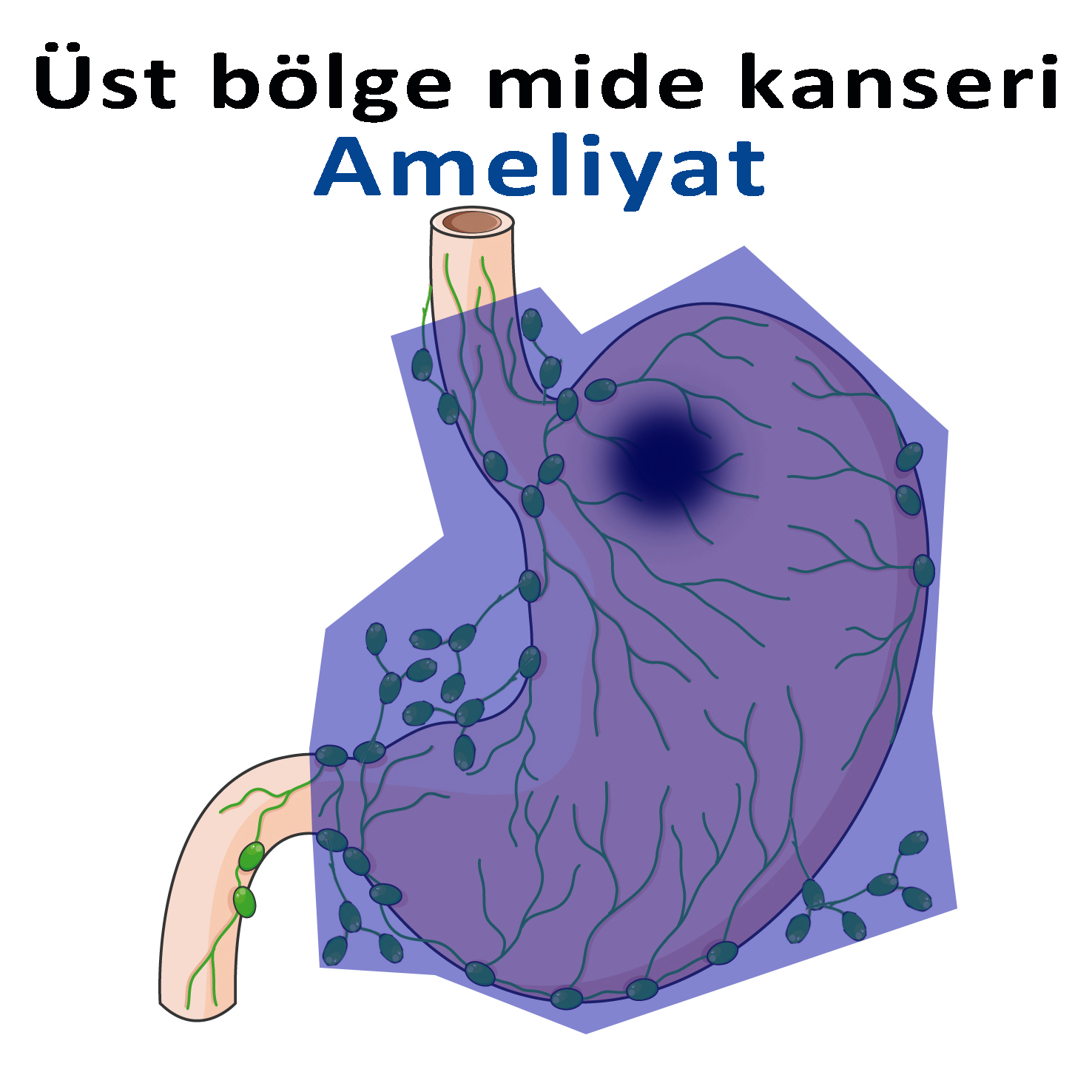
Surgery for middle stomach cancer
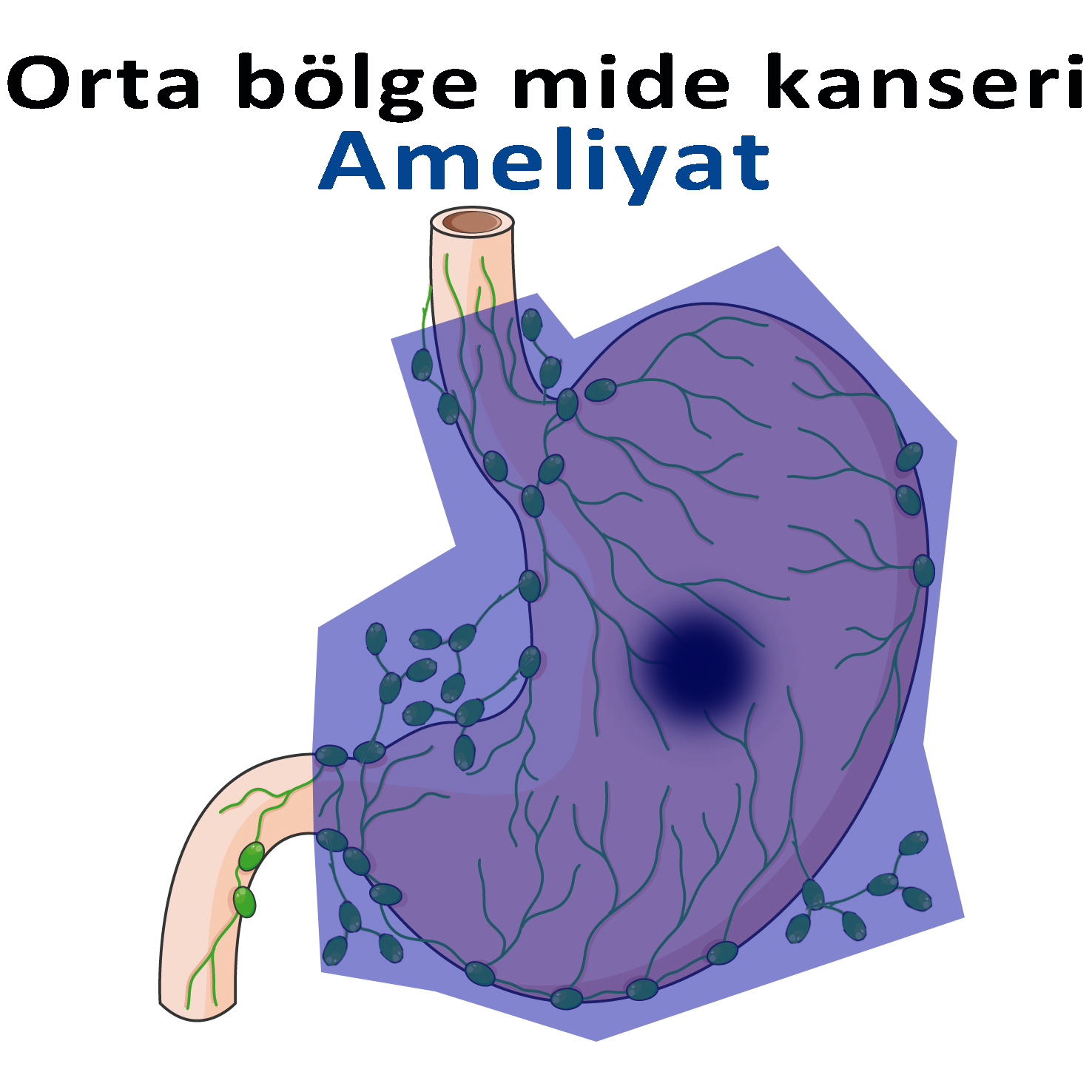
Surgery for lower stomach cancer
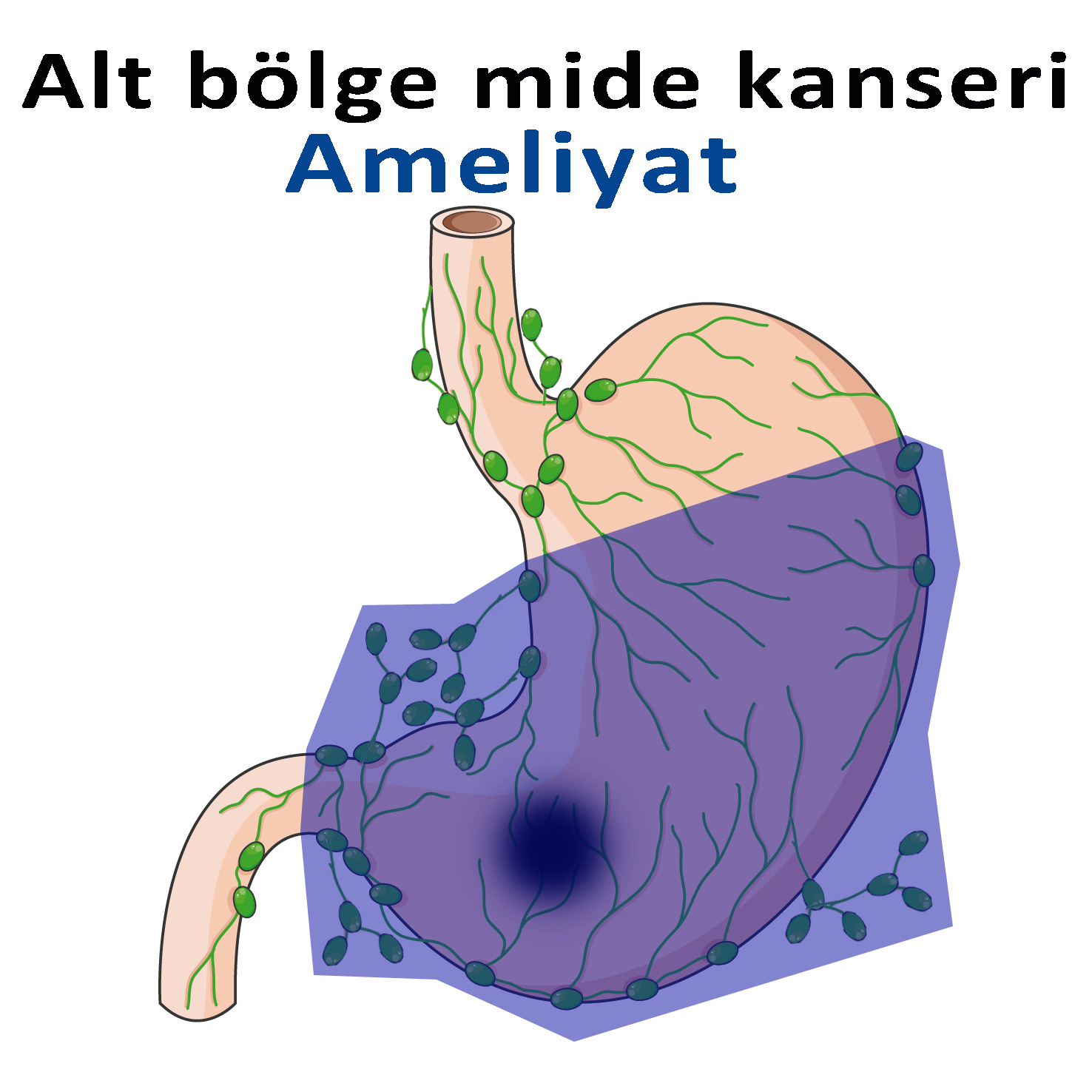
Early enough diagnosis of gastric cancer reduces both the portion of the stomach removed and the lymphatic cleansing required. In some patients, even the tumor part is removed endoscopically and no lymphatic cleansing is performed.
In the figure below, you can see the areas of gastric surgery and lymphatic cleansing in early gastric cancer in the blue-colored part.
Surgery for early stomach cancer
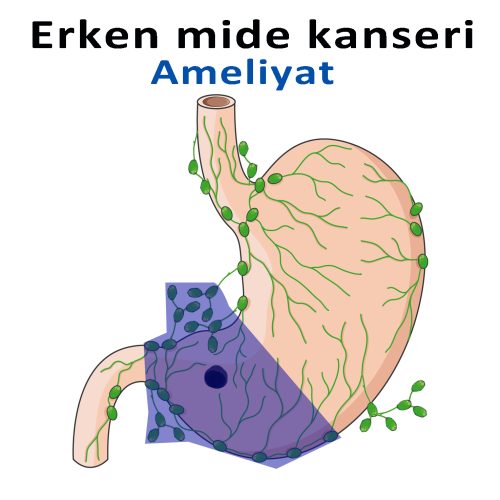
Examples of laparoscopic - robotic stomach cancer surgery
Stomach Cancer and Surgery - Frequently Asked Questions
Abdominal pain, weight loss, loss of appetite, nausea, weakness, indigestion, and difficulty swallowing are the most common symptoms of stomach cancer. Naturally, it cannot be said that every person with these symptoms has stomach cancer. These complaints can be due to dozens of different diseases and causes. Only one of these is stomach cancer.
Stomach cancer is diagnosed by examining the stomach with an endoscopy and taking a biopsy of the suspected mass. Of course, in addition to endoscopy, imaging methods such as tomography and PET are also very helpful in diagnosing the disease and determining its extent.
Yes, it is possible. Patients who are diagnosed at an early stage, when the tumor is small and treated correctly, can be completely cured of this disease.
Stomach cancer has a total of 4 stages. Stage 1 means that the tumor is detected before it grows, while Stage 4 means that the disease has spread to other organs. In our country, we mostly encounter stage 3 patients. In stage 3, the disease has grown in the stomach, involving the lymph nodes around the stomach, but has not spread to other organs.
In some patients with liver metastases from stomach cancer, surgical treatment is a necessary and appropriate approach. A detailed examination will determine which patient will benefit from the surgery.
In a small number of selected patients, surgery may also be beneficial in case of spread to the peritoneum. Hot chemotherapy can also be applied in these surgeries. The right patient selection is of great importance for this.
Yes, shrinkage is achieved in many patients with chemotherapy lasting 2.5 to 3 months before surgery, and then surgery is performed. Some patients are operated on directly without chemotherapy.
Yes, we operate on many of our patients with the laparoscopic closed method. This procedure can be performed with the success rates of open surgery.
If risky, from what does the risk arise? With a quality pre-assessment and meticulous surgical technique, the risks can be greatly reduced. The risk is usually caused by leakage at the seams, i.e. leaks. There are also ways to reduce the risk of leakage. In the past 4 years, we have discharged all our patients who underwent stomach cancer surgery.
The answer to this question depends on the location of the disease. While the entire stomach is usually removed for tumors located close to the upper part of the stomach, it is sufficient to remove a part of the stomach for tumors located in the middle and exit part of the stomach. The main goal here is to cleanly remove the disease completely.
Yes, the tumor-associated lymph nodes in the stomach are completely removed. Technically, this lymph node removal may have some differences when the whole stomach is removed and when part of it is removed.
Most patients who have received chemotherapy before surgery need chemotherapy for preventive purposes after surgery. In patients who did not receive chemotherapy before surgery, the need for subsequent chemotherapy is determined according to the stage of the disease.
Radiation therapy is needed in a small group of patients with stomach cancer. Sometimes radiation therapy is needed for tumors in the upper part of the stomach, usually the entrance valve.
Yes, sure. After stomach cancer surgery, we discharge our patients in a condition where they can eat boiled chicken, meatballs, and bread. At home, food intake can also be done within certain rules by sitting at the table with the family. So there is no deficiency, no disability.
Yes, especially in patients who have had their entire stomach removed, support with some nutritious drinks is useful for a few months after surgery. This need decreases in patients who eat well at meals.
Weight loss may continue for one or two months after surgery. Generally, this is 10-12% of the patient’s weight. For example, a weight loss of 7-10 kg can be seen in a 70 kg patient.
 More detailed information about laparoscopic stomach surgery can be found in the document indicated by the arrow. Please on the PDF file
More detailed information about laparoscopic stomach surgery can be found in the document indicated by the arrow. Please on the PDF file